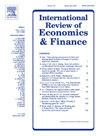How does digital economy influence urban common prosperity? Evidence from China's demonstration area for common prosperity
IF 5.6
2区 经济学
Q1 BUSINESS, FINANCE
引用次数: 0
Abstract
In the modern era, the digital economy has emerged as a crucial driver of economic growth, playing a significant role in advancing common prosperity through high-quality development. This paper investigates the influence of the digital economy on urban common prosperity and examines the mechanisms that underpin this relationship. Using Zhejiang Province, China's demonstration area for common prosperity as a case study, we analyze data from 11 prefecture-level cities over the period 2011–2021 to evaluate digital economy development and common prosperity levels. Through quantitative analysis, we examine the digital economy's direct effects on common prosperity, along with its indirect impacts through mediation mechanisms and spatial spillovers. The results show that the digital economy significantly enhances common prosperity, a finding consistent even after robustness checks using historical data as instrumental variables and substituting per capita digital economy patents. Mediation analysis conducted via the CMA approach suggests that the digital economy fosters common prosperity by stimulating entrepreneurship, boosting entrepreneurial activities, increasing disposable incomes, and reducing the urban-rural income gap. Moreover, spatial econometric models, such as the Spatial Durbin Model (SDM), show that the digital economy promotes common prosperity through spatial spillover effects. This study offers empirical evidence on how the digital economy can drive common prosperity in Zhejiang Province, offering valuable policy insights for the government's efforts to promote equitable growth, and serves as a reference for other regions across the country.
数字经济如何影响城市共同繁荣?来自中国共同富裕示范区的证据
进入现代,数字经济已成为经济增长的重要动力,为推动高质量发展促进共同繁荣发挥了重要作用。本文探讨了数字经济对城市共同繁荣的影响,并探讨了支撑这种关系的机制。本文以共同富裕示范区浙江省为例,分析了11个地级市2011-2021年的数据,对数字经济发展和共同富裕水平进行了评估。通过定量分析,我们考察了数字经济对共同繁荣的直接影响,以及通过中介机制和空间溢出效应产生的间接影响。结果表明,数字经济显著促进了共同繁荣,即使使用历史数据作为工具变量并替代人均数字经济专利进行鲁棒性检验后,这一发现也是一致的。通过CMA方法进行的中介分析表明,数字经济通过刺激创业、促进创业活动、增加可支配收入和缩小城乡收入差距来促进共同繁荣。此外,空间计量模型如空间德宾模型(spatial Durbin Model, SDM)表明,数字经济通过空间溢出效应促进共同繁荣。本研究为数字经济如何推动浙江省共同繁荣提供了实证证据,为政府促进公平增长的努力提供了宝贵的政策见解,并为全国其他地区提供了参考。
本文章由计算机程序翻译,如有差异,请以英文原文为准。
求助全文
约1分钟内获得全文
求助全文
来源期刊
CiteScore
7.30
自引率
2.20%
发文量
253
期刊介绍:
The International Review of Economics & Finance (IREF) is a scholarly journal devoted to the publication of high quality theoretical and empirical articles in all areas of international economics, macroeconomics and financial economics. Contributions that facilitate the communications between the real and the financial sectors of the economy are of particular interest.

 求助内容:
求助内容: 应助结果提醒方式:
应助结果提醒方式:


